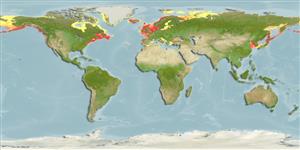Common names from other countries
Classification / Names / Names
Common names | Synonyms | Catalog of Fishes (gen., sp.) | ITIS | CoL | WoRMS
Environment: milieu / climate zone / depth range / distribution range
Ecology
Benthic; brackish; depth range 0 - 192 m (Ref. 78574), usually 0 - 25 m (Ref. 75831). Temperate, preferred 9°C (Ref. 107945); 77°N - 33°N, 180°W - 180°E (Ref. 113928)
Northwest Atlantic from Nova Scotia to Virginia, North Sea and European waters including the Black, Baltic, Wadden, White and Mediterranean seas, and northeast Pacific from San Francisco to Alaska.
Length at first maturity / Size / Weight / Age
Maturity: Lm ? range ? - ? cm Max length : 10.0 cm TL male/unsexed; (Ref. 7726); max. reported age: 8 years (Ref. 2823)
Minimum depth from Ref. 101279. Maximum depth recorded is 329 m (Ref. 101279). Lives in burrows in sand, mud, sandy mud and sandy gravels from the mid shore to the shallow sublittoral, sometimes to a depth of 192 m (Ref. 78574). Commonly found in estuarine areas, buried in substrate 10 to 20 cm deep (Ref. 95344). In the Vainameri (north-eastern Baltic Sea), abundant in silty substrate (Ref. 95753). Deposit/filter feeders (Ref. 95728). Identified as an ecologically important benthic species of the Baltic Sea, mainly as part of the food base of fishes and its contribution to biofiltration and biosedimentation processes (Ref. 95774). A microvore that feeds on organic detritus (Ref. 96352). Found both in intertidal mudflat and estuary (Ref. 2823).
Life cycle and mating behavior
Maturity | Reproduction | Spawning | Eggs | Fecundity | Larvae
Members of the class Bivalvia are mostly gonochoric, some are protandric hermaphrodites. Life cycle: Embryos develop into free-swimming trocophore larvae, succeeded by the bivalve veliger, resembling a miniature clam.
Harvey-Clark, C. 1997. (Ref. 7726)
IUCN Red List Status (Ref. 130435)
CITES status (Ref. 108899)
Not Evaluated
Not Evaluated
Human uses
Fisheries: commercial
FAO - Aquaculture: production; Fisheries: landings | FishSource | Sea Around Us
Tools
Internet sources
Estimates based on models
Preferred temperature
(Ref.
115969): 6.4 - 14.5, mean 10.9 (based on 360 cells).
Resilience
Medium, minimum population doubling time 1.4 - 4.4 years (K=0.14-0.48; tmax=8).
Vulnerability
Moderate vulnerability (39 of 100).
